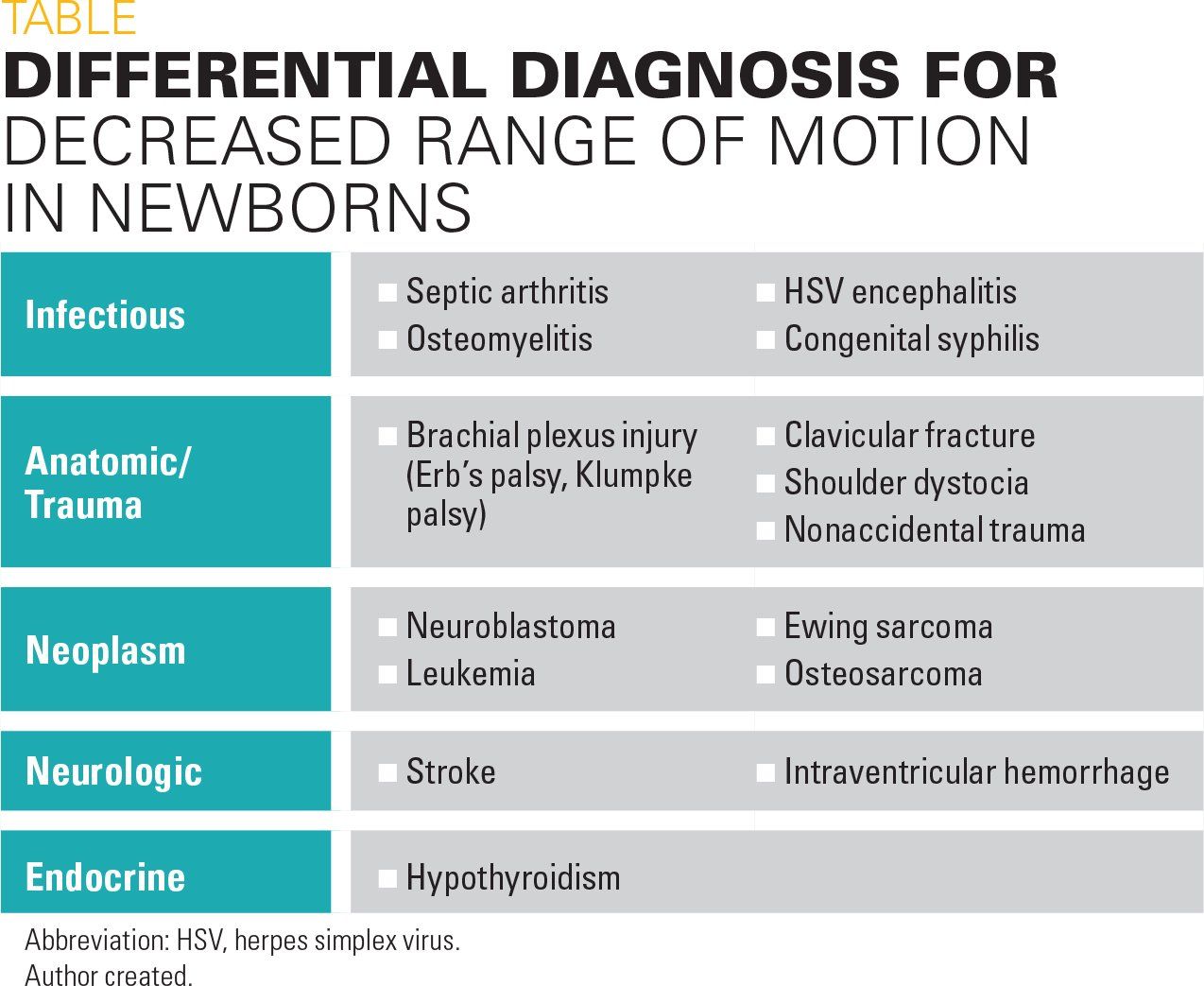Infant resists moving right shoulder or elbow
An 11-day-old, full-term male presents to the emergency department (ED) with a 2-day history of decreased range of motion of his right upper extremity.
Table 1

Figure

The case
An 11-day-old, full-term male presents to the emergency department (ED) with a 2-day history of decreased range of motion of his right upper extremity.
History
This patient was born to a 32-year-old G1P1 mother via induced vaginal delivery at 39 weeks’ gestation. Birth weight was 2955 g (19th percentile); length, 50 cm (44th percentile); and head circumference, 32 cm (9th percentile). Maternal blood group is B Rh-negative, antibody negative. Maternal group B Streptococcus (GBS) was unknown at birth but later noted to be positive by Obstetrics and not treated prior to birth. The patient’s neonatal course was complicated by hyperbilirubinemia, requiring 1 day of phototherapy.
Since discharge from the hospital, the infant has reportedly been moving his arm without difficulty until 2 days prior to presentation. According to the parents, he continues to use his hand and wrist but will not move the elbow or shoulder. There is no known trauma to the right upper extremity and no previous invasive medical procedures aside from a heel stick for routine newborn screening labs along with an uncomplicated circumcision. The family denies erythema, swelling, or increased warmth in the right arm or shoulder. He is acting appropriately, tolerating cows’s milk formula along with breast milk, and having normal wet diapers and stools. Newborn genetic screening is normal.
Physical exam and laboratory testing
The initial physical exam reveals temperature of 97.7°F; heart rate, 176 beats/minute; respiratory rate, 31 breaths/minute; blood pressure, 85/56 mm Hg; and SpO2 of 96% on room air. He is in no acute distress and is able to move his right hand and wrist. There are no spontaneous or active movements of the right elbow or shoulder, although there is normal passive range of motion. He has a normal right palmar grasp but an asymmetric Moro reflex with limited range of motion of the right shoulder and right elbow. There is no tenderness, swelling, crepitus, or deformity of the right shoulder.
Laboratory evaluation shows white blood cell (WBC) count of 17,300 x 109/L for age (lymphocytes, 34%; neutrophils, 55%; monocytes, 10%); platelets, 262,000/μL; hemoglobin, 14.6 g/dL; and hematocrit, 43%. Erythrocyte sedimentation rate (ESR) and C-reactive protein (CRP) are both elevated at 54 mm/h and 90 mg/L, respectively. Further laboratory tests are unremarkable including serum electrolytes, glucose, urinalysis, and cerebrospinal fluid (CSF) studies.
Differential diagnosis
Initial differential diagnosis on admission to the neonatal intensive care unit (NICU) included, but was not limited to, brachial plexus palsy, neonatal stroke, intraventricular hemorrhage, fracture, nonaccidental trauma, osteomyelitis, herpes simplex virus (HSV) encephalitis, and septic arthritis (Table). Because of concern for acute infection in an 11-day-old infant, the patient was started empirically on intravenous (IV) ampicillin, cefepime, and acyclovir after obtaining urine, blood, and CSF studies. Ampicillin was initiated to cover gram-positive organisms including GBS and Listeria, cefepime for Escherichia coli and methicillin-sensitive Staphylococcus aureus, and acyclovir for HSV.
Initially, the main differentials were brachial plexus palsy versus acute intracranial process. A head ultrasound was performed, which was negative. Subsequently, magnetic resonance imaging (MRI) of the head and cervical spine was obtained, not under sedation or general anesthesia, and found to be significant for a small subacute subdural hematoma in the posterior fossa bilaterally without significant mass effect. The cervical MRI was poor quality because of movement. The results were discussed with Pediatric Neuroradiology and Neurosurgery and were thought to be secondary to the birthing process and likely not contributing to the decreased range of motion of the right upper extremity.
With negative intracranial pathology as the cause for the acute presentation, there was concern for acute osteomyelitis of the right upper extremity versus brachial plexus palsy. An MRI of the shoulder and neck was obtained for elevated inflammatory markers. The MRI of the neck was negative; however, MRI of the shoulder was significant for increased T2 signal in the right humeral head that extended across the physis into the metaphysis of the right humerus and mild synovial thickening (Figure).
The diagnosis of right acute humerus osteomyelitis was made.
Discussion
Acute osteomyelitis in the full-term newborn is rare. Most cases described are those associated with a systemic infection, skin infection, complicated delivery, after an invasive operation, or in critically ill patients.1 Premature infants are at a higher risk in comparison with term infants because of invasive procedures, central line access, and frequent blood draws. Additionally, premature rupture of membranes, transplacental infections, low birth weight, and asphyxia have been linked to increased risk.2
Osteomyelitis in neonates has varied clinical presentations but often presents with the inability to move an affected limb, pain with movement, or local swelling and signs of inflammation. Zimmerman and colleagues reviewed literature from 1950 to 2016 of osteomyelitis of the humerus in the newborn and infant.3 In the 29 cases identified, the median age of symptoms was 14 days with first presentation at 21 days, all of which presented with concern for brachial plexus paralysis. A pathogen was isolated in 86% of infants with osteomyelitis of the humerus, most frequently with GBS followed by S aureus. Interestingly, S aureus is the most common bacteria usually found in osteomyelitis. However, in osteomyelitis of the humerus, GBS is the most common bacteria.
In neonates, the most common route of spread is hematogenous and the long bones are more frequently involved.1 In addition to S aureus and GBS, E coli, Klebsiella, Proteus, and, in rare cases, Candida albicans are isolated of osteomyelitis in the newborn.4 A recent report of salmonella also was reported, although it is extremely uncommon.5
It is important to keep a high index of suspicion for a newborn who is not moving an extremity and yet is well appearing with an uncomplicated history and low risk factors. According to Zimmerman and colleagues, more than half (16 of 29) of cases were initially misdiagnosed causing a delay in treatment.3 Delays in treatment can lead to concurrent septic arthritis, subperiosteal abscess, pyomyositis, deep vein thrombosis, growth arrest, septicemia, multiorgan failure, and death.4
Osteomyelitis and concurrent septic arthritis have been reported in multiple studies. Montgomery and colleagues identified that concurrent infection was seen in 72% of children with septic arthritis of the shoulder.6 The same study also concluded that risk factors for concurrent joint and bone infection were: newborn or adolescent ages; humerus involvement; 6 days of symptoms; and infection with methicillin-sensitive S aureus or methicillin-resistant S aureus (MRSA). Thus, it is imperative to not delay treatment and to obtain wound cultures prior to starting antibiotics if osteomyelitis is suspected.
As mentioned previously, GBS is the most-common isolated organism in osteomyelitis of the humerus.3 Pathogens are becoming resistant to multiple drugs, thus empiric therapy should include a third-generation cephalosporin plus an antistaphylococcal agent, such as oxacillin.7 If MRSA is suspected, vancomycin should be started while awaiting the results of the wound culture.8
Plain X-ray is not sensitive for the diagnosis of acute osteomyelitis. Destruction of the bone is visible up to 7 to 10 days after the beginning of symptoms and only 20% of patients who present in the first 2 weeks will have an abnormal X-ray.9,10 An MRI is the modality of choice with bone marrow edema as the earliest feature that can be detected-as early as 1 to 2 days after the onset of infection.10
In the present case, the GBS status of the mother was initially unknown. When GBS is proven, the drug of choice is penicillin. In this case, ampicillin and cefepime were chosen as empiric therapy for the patient along with acyclovir to cover for suspected late-onset sepsis. Acyclovir was discontinued once HSV cultures were negative.
An unusual case
The patient was initially healthy and had no known risk factors for infection. He began experiencing symptoms at day 9 of life, making him one of the youngest in literature with osteomyelitis. The patient showed no signs of infection, remained afebrile, had no cardinal signs of inflammation, and had negative cultures.
Street and colleagues described 49 pediatric patients with an average age of 4.2 years with osteomyelitis of the humerus. In this retrospective study, 78% were not using the affected limb and 70% complained of pain. Only 55% of patients were febrile whereas 78% were tachycardic.11
In a review article by Zimmerman and colleagues, 17% (5 of 29) of cases presented with fever or irritability.3 Therefore, it is imperative to suspect osteomyelitis in an afebrile and well-appearing neonate who has decreased movement of an extremity. Of note, the humerus accounts for 8% of osteomyelitis whereas the femur (27%) and tibia (26%) are most often affected.12
White cell count, ESR, and CRP were raised in 73%, 74%, and 79% of cases, respectively.11 The patient in this case had an elevated WBC count, ESR, CRP, and trouble with movement of his right upper extremity but was afebrile and was not fussy or showing signs of pain. Pääkkönen and colleagues reported that WBC count was normal in more than half of their pediatric cases with osteoarticular infections, while CRP and ESR together had a sensitivity of 98%.13 Therefore, leukocytosis is a poor indicator for the diagnosis of acute osteomyelitis.
Conclusion
Acute osteomyelitis is an uncommon but serious condition in the newborn. In adults, osteomyelitis is usually subacute or chronic and develops secondary to an open injury. On the other hand, in children osteomyelitis is acute and seeds hematogenously.
Acute osteomyelitis in an infant requires a multidisciplinary team involving Orthopedic Surgery, Infectious Disease, and General Pediatrics for prompt evaluation, diagnosis, and treatment to prevent long-term sequelae. Elevated WBC, ESR, CRP, and physical examination should guide a clinician who has a strong suspicion for osteomyelitis, and MRI should confirm the diagnosis. The most common pathogen in neonatal osteomyelitis is S aureus whereas the humerus is more likely associated with GBS. Antibiotics should be initiated as soon as a diagnosis of osteomyelitis is suspected. It is imperative to keep a high index of suspicion for a variety of pathogens in an era of antibiotic resistance and emerging strains.
Patient outcome
Pediatric Orthopedics was consulted and the patient was taken for immediate incision and drainage along with bone drilling of the right shoulder for osteomyelitis, right shoulder septic joint, and myositis. A drain was placed intraoperatively for drainage.
The patient’s blood culture, urine culture, and CSF remained negative. Cultures from the incision and drainage of the shoulder were negative in aerobic and anaerobic cultures. Likewise, the gram stain showed no organisms. Because of the age of the patient and negative cultures without sensitivities, a peripherally inserted central catheter was placed for 4 weeks of IV ampicillin and cefepime with good clinical response.
The patient had improved range of motion after 1 week of IV antibiotics and regained his full range of motion after 3 weeks. He had no residual adverse effects and has remained healthy since the incident.
